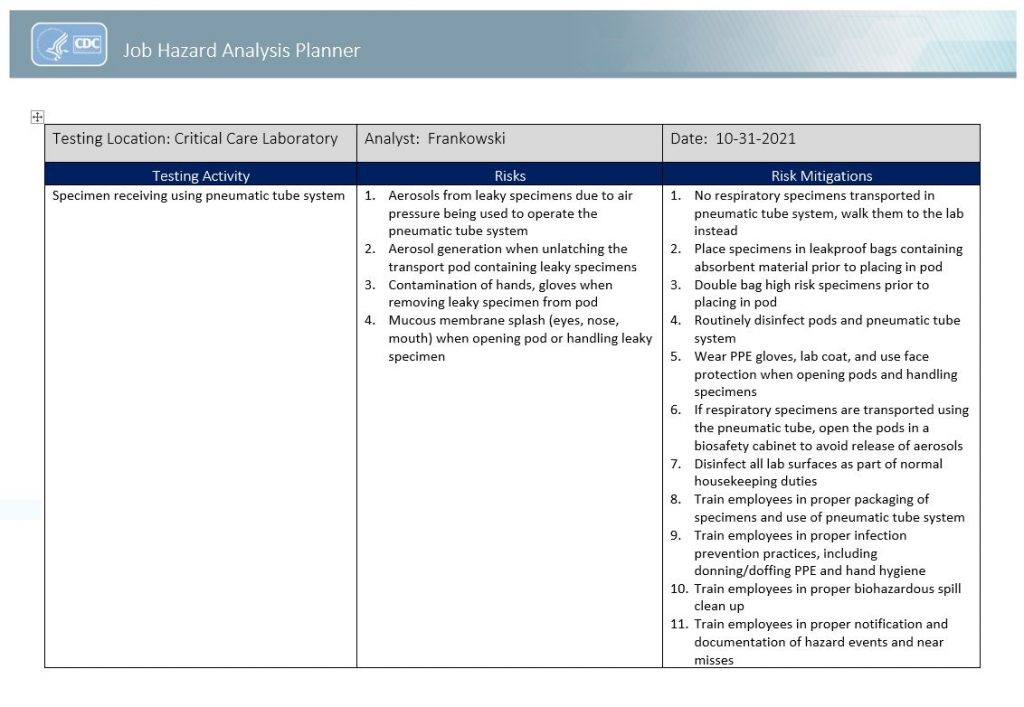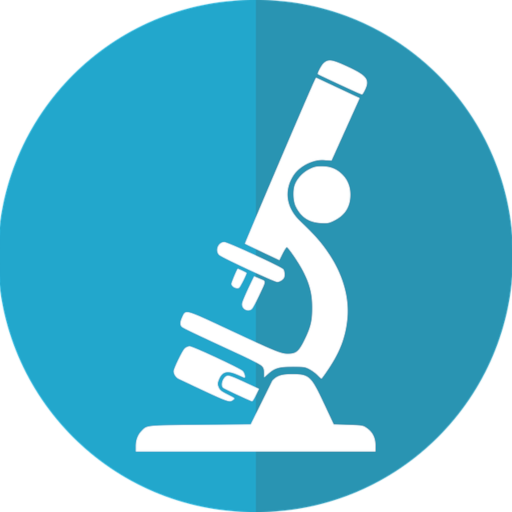Introduction
In Med Lab Study Hall’s blog Medical Laboratory Safety – Part 2: Biological Risk Assessment, I provided an overview of a biological risk assessment. I shared with you what inherent risk means and that part of a risk assessment is identifying steps in your laboratory processes that could cause unintended exposures to biological hazards. Today’s blog will focus on the tool and process for identifying those exposure risks, called a job hazard analysis (JHA).
Much of the information used in today’s blog is referenced in OSHA 3071, Job Hazard Analysis, 2002 (Revised). I’ll also provide an example using the Job Hazard Analysis Planner from the Centers for Disease Control (CDC). Additional resources for customizing your biological risk assessment and job hazard analysis can be found at the CDC website https://www.cdc.gov/csels/dls/bio-risk-assessment.html.
Why do the JHA?
The United States has an organization called the Occupational Safety and Health Administration (OSHA). This organization was created to ensure that US businesses did not use scrupulous practices in manufacturing or providing services that put their employees in danger when performing the duties required of their jobs.
In medical laboratories, biohazards are present in everything we do. Just walking into a laboratory where human specimens are processed is risky. Any surface could be contaminated. Aerosols could be generated by opening specimens – releasing viruses, bacteria, or fungus into the air for people to breathe into their lungs. Accidents when moving specimens throughout the lab can happen, causing spills of biological agents which could soak through your clothes or shoes if you are not wearing the right kind of personal protective equipment (PPE). You could be splashed in the face accidentally when aliquoting specimens into tubes to distribute to other areas of the lab. Specimen containers could leak when sent through the pneumatic tube system and potentially release infectious agents throughout the entire hospital. Working in a medical laboratory is definitely risky, and can be a bit scary.
Your employer’s goal, as well as OSHA’s, is to do everything it can to provide you the safest environment possible to perform your work.
Accomplishing that includes identifying risks so that mitigations can be implemented to minimize the risk to you.
Those risks are identified by performing a job hazard analysis.
What is a hazard?
In broad terms, a hazard is an item, situation, or practice that has the potential to cause harm.
If the hazard is left uncontrolled, there is a high likelihood that the hazard can result in injury or illness. Controlling the risks is done by using environmental controls, changes in process, or using personal protective equipment.
For example, a freshly mopped stairway is a hazard. The wet floor can be slippery. But we must periodically sweep and mop floors to keep them dirt-free and minimize build-up of mold and mildew, as well as to keep vermin away. Wet floors are a risk we must endure, and we mitigate the risk by posting wet floor signs to encourage people to either avoid the stairway until it dries or be very careful when deciding to use the wet stairs.
What is Job Hazard Analysis?
Job hazard analysis is a technique that lists the job tasks in a stepwise fashion to identify hazards before they occur.
The assessor considers the relationship between the worker, the task, the tools, and the work environment and how each contributes to potential exposure to the biological hazard.
Once the risks of uncontrolled hazards are identified, you should take action to eliminate or reduce the risk to an acceptable level by making environmental changes, or process changes, or requiring the use of appropriate gloves and protective clothing.
Review historic events of illness, accident, or injury
Every employer above a certain number of employees is supposed to track work-related or on-the-job accidents, injuries, and illnesses.
The JHA must include a review of all reported accidents, injuries, and illnesses to identify trends related to a particular task, piece of equipment, chemical, or biohazard. They should include situations known as “near misses” as well. Near misses are events where illness, accident, or injury could occur, but fortunately did not.
The trends, if they exist, will help prioritize which jobs need to be analyzed first.
The events will also indicate which hazard controls already in place may not be working to eliminate or reduce the hazard as originally anticipated.
Involve employees
The JHA includes
- talking to employees performing the risky job tasks and have them explain what they do
- observing them performing the tasks
- asking questions as you are observing to see if processes are followed exactly according to the written procedure
Involving employees who are performing risky tasks is invaluable because they know the tasks. They know when they feel unsafe performing a particular task. They usually will have ideas for eliminating or reducing the risk associated with the task. Their involvement minimizes the chance that you will miss something during your analysis. It also helps employees feel heard and own part of the improvement process, which is critical for them accepting the implemented mitigation solutions.
Conduct a review of the job tasks by discussing hazards with your employees. They may know of existing hazards and can help brainstorm ideas for mitigations to eliminate or reduce the hazard.
If this review identifies hazards that exist and pose an immediate danger to your employees’ lives or health, you must take immediate action to protect your employees. If the hazards easily can be addressed, correct them as quickly as possible, and don’t wait until your JHA is complete.
Keeping your employees safe and healthy is your top priority. Show it by fixing things as quickly as possible.
List all the hazardous jobs at the work place, rank them and prioritize for JHA
In the laboratory, when determining biological risk, there are different levels of risk based on which biohazards are being handled by whom. Once you’ve identified all the risky jobs and their tasks, you should prioritize them with the riskiest job being analyzed first.
For example, in the critical care lab, employees handle blood and body fluids containing viruses such as hepatitis and HIV. These do not cause airborne exposures when handled under normal conditions. In the virology laboratory, they handle SARS-CoV-2 (Covid-19) specimens containing live virus. If these specimens are handled in the same fashion as blood specimens, there may be virus released into the air that could cause exposure to employees causing illness. In this case, you would prioritize mitigations for the virology lab over those for the critical care lab.
List steps or tasks in each hazardous job
Now that you know which job is being analyzed first, work with your employees to list each step in that job.
When using the OSHA JHA form, the risk and risk mitigations shown in the CDC form are broken down into more specific categories, such as hazard type (physical, biological, chemical), hazard description, consequence of uncontrolled hazard exposure, and recommended hazard controls (risk mitigations).
The CDC form offers a simplified documentation system to highlight the risks and what you plan to do to eliminate or minimize them.
Each step or task should have all risks identified and mitigation strategies listed for laboratory leadership and frontline employees to review, as in this example:
Sample JHA

Image created by Med Lab Study Hall using CDC JHA Planner
Continue documenting tasks/testing activities until all that was listed when you set your job prioritization have been completed.
Review JHA with leadership and discuss recommended action plans
Once the JHA is complete, schedule time to present the data to laboratory leadership and anyone else they would like to be part of the review. Point out the risks in the process, the standards or regulations that might support the recommended mitigations (such as OSHA, Environmental Protection Agency, or College of American Pathologists), and what some possible hazard corrections/risk mitigations might be. Mention that these are recommendations only, and laboratory leadership can use the information to decide how best to eliminate or minimize the risk.
Some of the risk mitigations selected may require significant financial resources, remodeling of laboratories, or equipment purchases. This might need to go through the budgeting process and obtain approvals from higher leadership at the facility before anything can be done. If that is the case, the JHA and overall biological risk assessment are strong supportive documentation for the approvals and financial investment.
Periodically review the JHA for changes and involve a professional evaluator, if needed
It’s a good idea to walk through the processes at regular intervals, such as annually, or if something changes in the process so that you can see if any new risk points have been introduced.
You should also take a look at the analysis if an illness or injury occurs to see if something may have been missed in the original analysis. Periodic review and observation also verify that employees are adhering to implemented mitigations. If the mitigations are causing employees to bypass them, resulting in hazard exposure, alternate mitigations should be considered.
You may need outside help with your JHA if your employees are involved in many different or complex processes. Your local fire department, insurance company, OSHA, or the Bureau of Workman’s Compensation can offer assistance performing evaluations and contributing to the entire biological risk assessment process.
It is important to maintain employee involvement in the process even if you hire outside professionals. You and your employees are on the job every day and will help ensure that hazards are not overlooked.
Conclusion
A Job Hazard Analysis is an effective tool to use in an overall Biological Risk Assessment. It identifies biological exposure risks so that employers can implement appropriate actions to eliminate or reduce the risk. This results in fewer illnesses, injuries, and fatalities related to the job. It also motivates employees to work more safely. Remember, the end goal is to keep employees from becoming infected with biological agents or other hazards in the laboratory. Tools to help develop safety processes benefit us all.
Stay tuned to our website for Part 4 of our Safety Series, where I discuss the Biological Safety Levels needed for the various levels of risk associated with biohazards.

